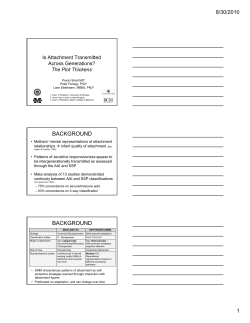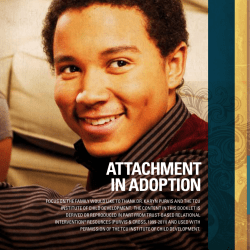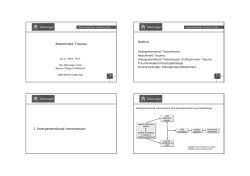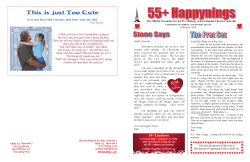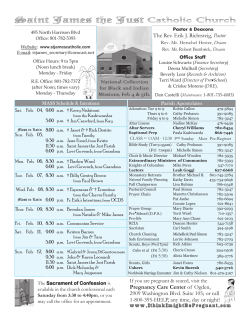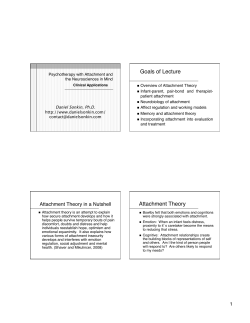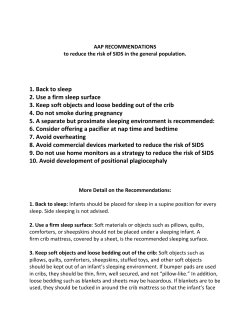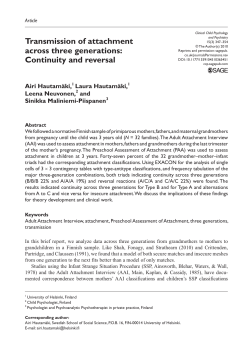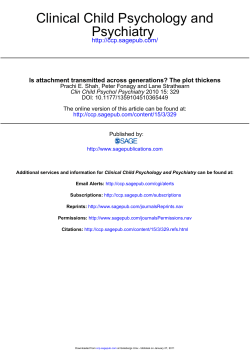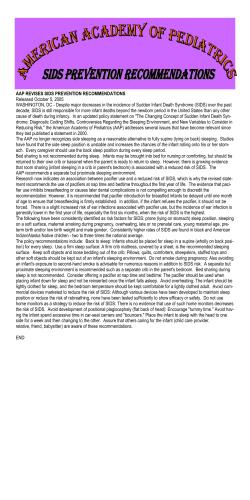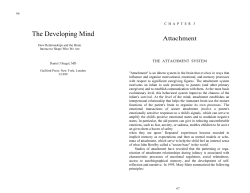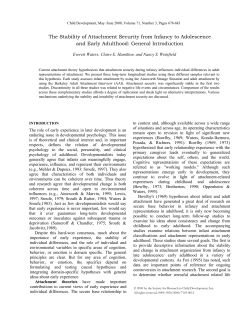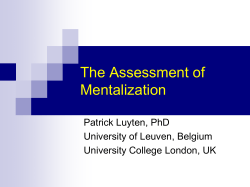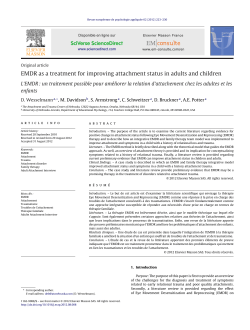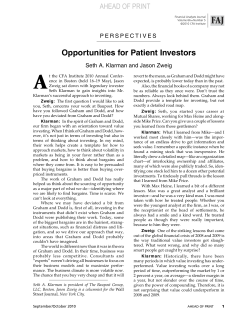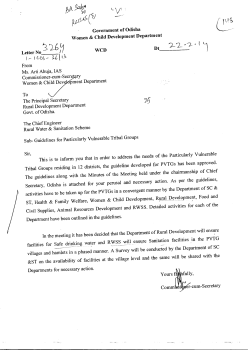
MA Practice-based Play Therapy APAC / Christchurch Canterbury University
MA Practice-based Play Therapy APAC / Christchurch Canterbury University draft research proposal Debi Maskell Graham Student No: MAS06953257 February 2008 ******* Title: “Baby Bonding” An evaluation of directed movement and lullaby activities on maternal behaviours associated with secure attachment in the early post-partum period. Research question: Does the use of directed movement and lullaby activities effect maternal behaviours associated with secure attachment in the early post-partum period? Aims and objectives: to evaluate the effect of gentle movement and lullabies on specific maternal behaviours during the study debi maskell graham Student No: MAS06953257 MA Practice-based Play Therapy Draft Research Proposal, Feb 2008 1 to identify any changes in how mothers engage with and interact with their babies through movement and lullaby Introduction This research study will evaluate the effect of movement and lullaby on maternal behaviours associated with attachment in the early post-partum period. ur months at the start of the study. Mothers will be the primary carer; of middle socio-economic status and of white British heritage. Babies will be between 6-12 weeks at the start of the study. The literature review will examine attachment theory; the neurological basis of human relationship; authentic movement; object relations; and Jungian / post-Jungian theories of mother-child relationship. Whilst these strands encompass large bodies of research, there is no specific research examining movement and lullabies and maternal behaviour associated with secure attachment with infants aged under one year. This study will be conducted with a research sample of parents with no post-partum psychiatric symptomology as described in both the DSM-IV-TR and the ICD-10. The DSM-IV-TR is limited in its classifications for postnatal mood disorder with an onset specifier of only four weeks and just four diagnoses. However, in the text, specific indicators are identified, for example, a disinterest in the infant, guilt because of the dissonance between the mother’s actual mood and society’s expectations of debi maskell graham Student No: MAS06953257 MA Practice-based Play Therapy Draft Research Proposal, Feb 2008 2 happiness, and an impaired development of the mother-infant relationship (p.422423). This study will also preclude parent-child relational problem (V61.20, DSM-IVTR). The ICD-10 has a slightly longer onset specifier of six weeks for classifications of post-partum mental and behavioural disorders that cannot be classified elsewhere (F53) and are also precluded from this study. Literature review Mother-infant interaction has been the subject of vast scholarly research and debate. For the purposes of this study, Bowlby’s attachment theory (1969; 1973) together with his and Ainsworth’s (1969) ethological and observational methodology, will be the starting point for review. Bowlby’s seminal work provided developmental psychology with both an empirical and theoretical framework in behavioural biology (Grossman; Grossman; Waters; 2005). Bowlby’s fascination with the mother-child relationship, as observable behaviour, challenged the psychoanalytical stance of taking symptomology and retrospectively creating an hypothesis on causality. Ainsworth’s Strange Situation became the main empirical tool for the study of infantparent attachment patterns until the mid 1980s. Her notion of maternal sensitivity in promoting infant security is a key concept for scrutiny in this study. Main, Kaplan, and Cassidy (1985) then began to study attachment relationships in terms of representation with their Adult Attachment Interview (AAI). The first debi maskell graham Student No: MAS06953257 MA Practice-based Play Therapy Draft Research Proposal, Feb 2008 3 representational attachment measure for children, the Separation Anxiety Test (SAT) was developed by Kaplan from Klagsbrun and Bowlby’s (1976) earlier version. For the first time, a correlation was evident between infant-parent interaction in the Strange Situation, and subsequent representation classification in both the AAI and SAT responses. These findings verified Bowlby’s proposal that internal working models of self and attachment figure were retrievable in memory and have profound implications for this study focusing on parental attachment behaviours. Sroufe’s (1976; 1983) early work regarding infant affect placed attachment theory in the context of developmental theory and took the emphasis away from a simple correlation of outcomes of early attachment. This led to an organisational or systems perspective born out in longtitudinal studies such as the Minnesota Study (2005). This is also seen in the work of Stevenson-Hinde (1988) who advocates a continuum of bidirectional influences between personological and relational rather than a temperament versus relationship model of attachment. Belsky’s Pennsylvania Infant and Family Development Project (1984) comprising four short longtitudinal studies over the prenatal period; the newborn; observations at one, three and nine months; and the Strange Situation Test at 12-13 months; provides a questioning of the attachment assumptions in the interpretation of the results. The results of the study indeed appear to support a causality sequence. Maternal sensitivity is affected by contextual stresses and supports which affects the emotional and temperamental development of the child, in turn affecting the nature of attachment, secure or otherwise. This is also an accurate predictor of later debi maskell graham Student No: MAS06953257 MA Practice-based Play Therapy Draft Research Proposal, Feb 2008 4 relationality. However, Belsky also addresses the “whys” and “hows” of these developmental processes. Steel and Steel’s (Grossman; Grossman; Waters; 2005) London Parent-Child Study is fascinating. Central to the investigation and of particular interest to this study, is the phase 1 infancy assessments results. Expectant parents firstly completed the AAI in the third trimester of pregnancy. When the infant was 12 months, a Strange Situation was carried out with the mother, and at 18 months old with the father. Concurrently with the maternal Strange Situation, parents were interviewed by students unaware of the data collected from both the AAI and the Strange Situation. Parents recorded 20 minute interviews about what they liked best and least about their baby and being a parent. From analysis of the interview transcriptions according to a series of scales, students produced reliable ratings of how loving, rejecting, ambivalent and coherent the mother was whilst speaking about her baby. This was shown to correlate reasonably well to the results of the Strange Situation. However, the AAIs, collected well before the baby was actually born, provided a much more robust and compelling indicator of infant-mother attachment security at 12 months (Grossmann; Grossmann; Waters; 2005). This would suggest that adult internal working models of attachment are critical in the subsequent development of mother-infant attachment. Daniel Stern (1977; 1985; 1990) examines developmental issues from a psychoanalytic perspective suggesting that infants differentiate themselves almost debi maskell graham Student No: MAS06953257 MA Practice-based Play Therapy Draft Research Proposal, Feb 2008 5 from birth and then move through increasingly complex ways of relating; a far cry from Mahler’s first month of “natural autism.” This subjective sense of self or intersubjective relatedness is a mutual and non-verbal experience described by Stern as affect attunement. The importance of Stern’s affect attunement for this study is as a precursor of maternal empathy. Klein (St. Clair, M., 2004) developed Freud’s emphasis on instinctual drives to include relationality. Infant intrapsychic development was acknowledged from birth. Thus, psychoanalytical study began with the early dyadic mother-infant relationship. Klein layed the foundations for and developed the early terminology of object relations theory. Fairbairn (St. Clair, M., 2004) developed Kleinian ideas further, placing greater emphasis on the early mother-infant relationship. Winnicott (1965) developed the notion of the “good enough” mother; a mother who responds and changes according to the needs of her infant. His term “primary maternal preoccupation” (1965) is of particular interest in the context of this study as is his notion of infant maturation processes existing both as inherited tendencies and as a result of parental caring. Mahler (1975) posits that the infant begins life in undifferentiated symbiosis with the mother from which the notion of normal autism arises. What is interesting in Mahler’s work, is her observational methodology. This stood in stark contrast to psychoanalytic constructionism. debi maskell graham Student No: MAS06953257 MA Practice-based Play Therapy Draft Research Proposal, Feb 2008 6 Kernberg (1980) makes an important contribution in his assertion that individuals are primarily social creatures. Thus, it is relational experience that creates structure within the psyche as opposed to the id structuring reality. Kernberg’s emphasis is interesting in the context of current neuroscientific thinking. Kohut’s self psychology (1977) rebuffed any association with psychoanalytic theory, rendering instinctual drives only to a fragmented self. In particular, he reformed the role of narcissism in constructing a coherent self. Kohut’s reconceptualising of traditional psychoanalytical constructs is taken still further by the erudite Mitchell (1998) whose atheoretical approach makes a paradigm shift from object relations to a relational model. Thus, relationships configure the mind. Infants are intrinsically seeking relationship as the very expression of being human. This is the relational matrix paradigm. Neumann acknowledged the achievements of Freud in precipitating a decline in the patriarchal canon (Paglia, 2006). However, Freud was arguably entrenched in the “Father-God” modality with no credence for the preceding earth mother; matriarchal; goddess world. Neumann (1954, 1955, 1973) therefore looked to Jung’s system and the rich psychic world of mythological motifs and the existence of a suprapersonal creative power. Neumann posited that the Self exists in essence before development begins and subsequently unfolds during the course of life. The earliest phase of development is the primal relationship whereby the post-birth mother/child relationship is one in which the child has no sense of self and other. The initial sense of security and availability found in this first relationship sets the foundation for emotional relationality in all subsequent relationships. debi maskell graham Student No: MAS06953257 MA Practice-based Play Therapy Draft Research Proposal, Feb 2008 7 Neumann (1954) charts the “mythological stages in the evolution of consciousness” through the creation myth; the hero myth; and the transformation myth, as identified with the Egyptian god Osiris. The first stage is a fusion of ego and unconscious and deemed the matriarchal, symbolically represented in the uroboros. The fascination of this ancient symbol to this study, is in the serpent giving birth to itself yet devouring itself; solipsism and fertility symbolically concretised. Certainly, the ancient Great Mother was both benevolent and terrifying embodied in the Hindu goddess Kali. Grof is a major protagonist in the development of depth psychology and his theory of Basic Perinatal Matrices (BPM) and his “systems of condensed experience (COEX) (1985) are pertinent to this study. Grof attributes four phases of the physiological experience of birth with a matrix of potentials expressed in medical, emotional and archetypal themes. The interaction of these potentials are seen as influential in subsequent life experience. The use of touch and movement are a powerful tool in perinatal and preverbal experience as seen in the theory and practice of Body-Mind Centering, developed by Bainbridge-Cohen (1986; 1993); and Authentic Movement, originated by Whitehouse (1999), and further developed by Chodorow (1999) and Adler (1999; 2002). Both of these approaches invite a dialogue between consciousness and the unconscious through movement, body awareness, and touch. Movement patterns embody important developmental tasks with which the infant is engaged in the process of developing a sense of self and a healthy psychological core. These ideas will underpin the movement aspect of this study. debi maskell graham Student No: MAS06953257 MA Practice-based Play Therapy Draft Research Proposal, Feb 2008 8 The neuroscientific basis of the developing social brain has been the most recent contribution to this field. For perhaps the first time, a clear argument emerges that brings clarity to the mind-brain dichotomy. Schore (1994), Panksepp (1998), Siegal (1999), Gerhardt (2004), and Cozolino (2006) address the earliest experiences of relationship in a fusion of neurology, psychology, psychoanalysis, psychiatry and biochemistry. Neurobiological responses of the infant and the social construction of the brain in the earliest relationship are fundamental to our understanding of emotional and psychic development, in particular gerhardt’s notion of the “external foetus” (2004) and the role of the limbic system. These will be explored at length in this study. It seems fitting to end the literature review with reference to the archetypal psychology of Hillman (1996) and his transpersonal notion of “acorn theory.” Hillman asserts that we should not forget that psychology is actually about psyche; and that psyche is manifest soul. He affirms the infant’s unique destiny and accepts pathology as part of the fulfilment of such. This would include any so-called attachment difficulties. There is no place for blame then. A parent’s role is not to provide the ideal environment for the infant or else be blamed for the child’s maladaptive tendencies. The researcher is keen to be understood in these terms. The interest in this study is to examine the nature of the mother-infant interaction. It is not a veiled search for a potential parenting “technique.” debi maskell graham Student No: MAS06953257 MA Practice-based Play Therapy Draft Research Proposal, Feb 2008 9 Likewise, this study encapsulates a rigorous research methodology validated by empirical data analysis. However, the researcher is mindful of the soul quality of that first vital relationship of mother and baby. Empiricism must dance with esotericism and Neumann’s “zeitgeist”, the force that drives creative artistry, can also enrich and deepen this enquiry. “Behold the pearl of the soul in the oyster shell of the body …” (Rumi) Methodology This is a hermeneutic and systematic inquiry into the relationship between movement and lullabies and maternal behaviours associated with attachment. Baseline quantitative data will be collected via an initial online parental attachment behaviour assessment tool, the Experiences in Close Relationships – Revised (ECR-R). This is not a primary research tool given the inherent validity issues associated with selfassessment questionnaires. At the beginning, middle and end of the study, the Massie Campbell Scale (A-D-S) will be used together with analysis of three photographed sandtrays per dyad made by the parent. Recorded observations during the movement and lullaby sessions themselves will be the third main research method. Research sample The study will involve five to eight mother-infant dyads. Mothers will be white British, of middle socio-economic status, having experienced normal delivery. Infants will be first-born with no known complications or ongoing health issues, of both genders debi maskell graham Student No: MAS06953257 MA Practice-based Play Therapy Draft Research Proposal, Feb 2008 10 aged 6-12 weeks at the start of the study. Infants will have been breastfed as the initial feeding method. Participant recruitment This study will be based at a local community centre in a small rural market town in Nottinghamshire. Recruitment is through the local National Childbirth Trust, other parent support groups such as La Leche League and through community midwifery and health visitor links. Study design The research study will take place over a maximum of twelve weeks. Mother-infant dyads will be invited to attend ten weekly 45-minute sessions of directed movement and lullaby activities at a regular day and time each week together with short interviews with the researcher at the beginning, middle and end of the study. Parents will initially complete an adult attachment questionnaire online; the Experiences in Close Relationships – Revised (ECR-R) by Fraley, Brennan, and Waller (2000) (attached). This assessment is being used owing to recommendations to researchers in attachment to use a 2-dimensional measure. Fraley and Waller’s chapter in Simpson and Rholes (1998) has shown the lack of evidence for a true attachment typology. This tool produces graphical results in terms of conceptual dimensions or styles using continuous scales. debi maskell graham Student No: MAS06953257 MA Practice-based Play Therapy Draft Research Proposal, Feb 2008 11 During the first week, dyads will attend an initial interview. The Massie Campbell Scale (A-D-S) will be completed by the researcher (attached). This will generate succinct data described through the key parameters of gazing, affective sharing, vocalising, touching, infant clinging, parental holding and physical proximity. These components are then graded for the intensity of avoidance or attraction between parent and infant. The A-D-S is a long-established tool specifically designed for rapid use by paediatricians and mental health practitioners. Infant developmental norms will be tracked alongside the A-D-S using an “ages and stages” approach adopted by Schaefer and Digeronimo (2000) and Leach (1997). Each parent will additionally represent their relationship with their baby in a still undirected symbolic sandtray. Symbols will be chosen from a standard set to make a “picture” in the sand. This will be photographed. Parents will be invited but not induced to comment on the sandtray and any commentary or narrative will be recorded. The second phase will comprise of five weekly 45 minute sessions of directed movement play and lullaby activities in a small group setting designed around five themes: attunement, focusing, empathy, reflecting, and containment. These sessions will involve video capture or an independent observer. An interim interview comprising a second A-D-S assessment and a second photographed symbolic sandtray will take place. debi maskell graham Student No: MAS06953257 MA Practice-based Play Therapy Draft Research Proposal, Feb 2008 12 A third phase of five weekly 45 minute sessions of movement play and lullaby activities will follow. The final phase will comprise of an A-D-S and symbolic sandtray. Parents will also contribute a short unstructured recorded exit interview. These interviews may serve to honour the experience of the parents and illuminate quantitative analysis still further. Data analysis The initial data from the ECR-R will provide a baseline of parent attachment behaviour which will be analysed and presented as a series of graphs. Three A-S-D’s will yield data regarding the intensity of the avoidance or attraction between parent and infant on a set of succinct indicators as above. Changes in the scores will be tracked through the life of the research study for each dyad (beginning, middle and end.) Three symbolic sandplay representations will be photographed and analysed by at least two independent sandplay therapists. Analysis will follow a coded system, along with interpretative data. The movement and lullaby sessions will be evaluated throughout using a coded observation system either facilitated through video capture or an independent observer. debi maskell graham Student No: MAS06953257 MA Practice-based Play Therapy Draft Research Proposal, Feb 2008 13 A recorded and unstructured exit interview is planned. This may elicit useful data but is also seen as an important aspect of honouring the human experience of the study and as a means of closure for the participants. Data analysis will include statistical extrapolation in graphical form. For example, mean, medians, quartiles, and trend analysis. In addition, analysis over a much larger population may be attempted using techniques such as Monte Carlo simulation. Study timetable The draft Research Proposal; Application for SPEC Approval; Research Ethics Review Checklist; and SPEC Declaration will be submitted for approval in Spring 2008. The literature review and study design began in February 2008. Recruitment of mother-infant dyads will begin late Spring 2008. The research study will commence either Summer or Autumn 2008. Data analysis and writing up will take place Winter 08/09 with a projected submission date of Spring 2009. Ethical considerations PTUK (The United Kingdom Society for Play and Creative Arts Therapies) Ethical Framework and the BACP (British Association for Counselling and Psychotherapy) Code of Ethics will provide the ethical framework for the study including a complaints debi maskell graham Student No: MAS06953257 MA Practice-based Play Therapy Draft Research Proposal, Feb 2008 14 procedure. In accordance with McLeod (2003), the research study design is guided by the principles of beneficence, non-malificence, autonomy and fidelity. Legally Valid Consent Participants will become involved only on the basis of freely given and informed consent. Parents and infants will be equally honoured within the research process even though parents take full parental responsibility throughout. The researcher will provide parents with an information pack including: the purpose of the research study and intended audience the aims of the research potential benefits / difficulties freedom for participants to withdraw at any point without giving a reason freedom for a parent to not participate in a particular activity without giving a reason confidentiality and its limits how information will be used for the purposes of the study and the difference between anonymity and confidentiality how information will be stored, in which forms and for how long (a period of five years is recommended by BACP) how information from the research study will be used for submission to Christchurch Canterbury University and to journals the researcher’s name, qualifications, insurances, CRB checks and other pertinent information debi maskell graham Student No: MAS06953257 MA Practice-based Play Therapy Draft Research Proposal, Feb 2008 15 full details of parental responsibilities the complaints procedure (detailed below) Beneficence and non-maleficence This study has been carefully designed to be a safe, nurturing and beneficial approach to research with parents and small babies. Baby behaviour will be closely monitored and withdrawal suggested if it appears that an infant is unduly stressed by the process or indeed their parent. If the research study becomes generically unhelpful or its hypotheses or methodology become invalidated, the research process will be stopped and reconsidered. Autonomy The parent and infant’s right to autonomy will be upheld throughout. The right to choose not to participate in any specific activity or indeed the research study in its entirety will be upheld even if the validity of the study is compromised. Parents will have freedom to choose within the suggested session framework to engage with their baby in a way that they are comfortable and autonomous with. Parents may wish to contribute their views or thoughts during parts of the process but will not be induced to do so. Parents will be encouraged and empowered to follow their baby’s signals and wishes throughout the entire process even if that means they cannot actively participate during a timetabled session. debi maskell graham Student No: MAS06953257 MA Practice-based Play Therapy Draft Research Proposal, Feb 2008 16 Fidelity All participants will be treated in a fair, consistent and compassionate manner. All parents will receive the same information and access to the researcher. Each individual interview will be the same length and follow the same pattern. Care will be taken by the researcher to follow the same procedure for each assessment tool with a “scripted” card to follow. Any concerns that arise during the research will be recorded together with the agreed action. Parents will be aware of their right to make a complaint either directly to the researcher or to the course director. These contact details will be given to the parents in the information pack as below. Confidentiality, Anonymity and Data Protection All participating dyads will be coded and the codes kept in a locked metal filing cabinet in the researcher’s office. No identifying information will be included in the final dissertation or in any other dissemination document. Consent forms will be kept separately to protect identity. All assessment reports will also be coded. Digital sandplay photographs will be coded and stored separately on a disk in the locked filing cabinet. All digital material (jpegs, wav files, video clips) will be stored on a disk plus a backup disk and will immediately be deleted from cameras and other recording equipment. Anonomised data analysis and text will be stored on the researcher’s laptop in encrypted volumes only accessible by password. Upon completion, all electronically-stored data will be transferred to disk in the locked filing cabinet only. All records and research data relating to them can be accessed by the participants. debi maskell graham Student No: MAS06953257 MA Practice-based Play Therapy Draft Research Proposal, Feb 2008 17 Limits to confidentiality will be explained and, in particular, the procedure in the event of concerns or disclosure relating to the safety of any of the parents or infants. Concerns would be passed on and registered with the Duty Officer at the appropriate social services department. The researcher’s supervisor and course supervisor would also be informed in writing. Complaints A complaint or concern can be raised at any time during the research process. These will be recorded together with the agreed action. Formal complaints can also be made directly to: The Course Director, APAC, Fern Hill Centre, Fairwarp, Uckfield, Sussex, TN22 3BU, telephone (01825) 712312. Details of relevant insurances / enhanced disclosure The researcher is fully covered for both Public Liability and Professional Indemnity. Full criminal records bureau (CRB) enhanced disclosure is current and valid. The researcher is also First Aid for Babies and Children trained. Change(s) of focus during the study Changes to the research focus will be addressed with the researcher’s academic supervisor; amendments of the original research proposal made and new approval sought. If this is not possible or ethical, the research study would stop and a new research study proposal developed. debi maskell graham Student No: MAS06953257 MA Practice-based Play Therapy Draft Research Proposal, Feb 2008 18 Supervision and Monitoring The researcher works with full clinical supervision and governance procedures. An academic supervisor is also appointed for this specific piece of research. Validity problems An inadequate sample size would undermine validity so a larger number of motherinfant dyads are being sought in order to allow for those who may discontinue. If the number of participants dropped below the required sample size (n=4), the research study would be postponed and additional participants recruited. Regular attendance is seen as a potential threat to validity which will be monitored throughout. All procedures will be carried out by the same researcher following a “scripted” card to ensure that each part of the process is as uniformly delivered as possible protecting validity. The researcher is aware of her own bias and assumptions in the interpretation of data. This will be objectively identified in the presentation of the research findings. The researcher is using three independent and validated research methods, at least one of which will be analysed by expert therapists outside the research process. Any findings will also be framed within the cultural and social context of this study. debi maskell graham Student No: MAS06953257 MA Practice-based Play Therapy Draft Research Proposal, Feb 2008 19 The current research study design does not specify a particular gender configuration within the mother-infant dyad. This may well be an important variable but was considered a restrictive factor in the recruitment of participants. Any findings will be included in the data analysis. The researcher is the biggest potential influence on the research process. Issues of transference and counter-transference will be constantly monitored through the supervisory process. Changes within the participants’ own circumstances would potentially compromise validity and will need to be accounted for in the data analysis. Parents will have the opportunity to report any such changes but may choose not to do so. Word count: 4107 (excluding bibliographies) debi maskell graham Student No: MAS06953257 MA Practice-based Play Therapy Draft Research Proposal, Feb 2008 20
© Copyright 2026


